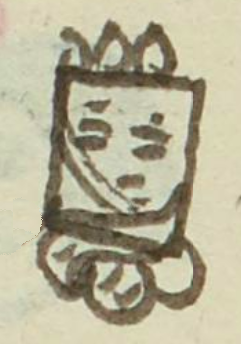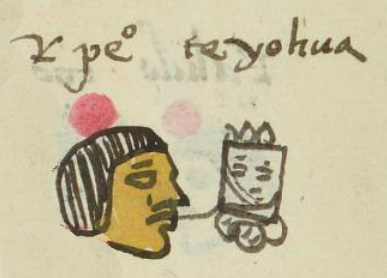Teoyohua (MH616v)
This black-line drawing of the compound glyph for the personal name Teoyohua (perhaps "Possessor of Divinity") is attested here as a man's name. The glyph shows a vertical stone (tetl) with curling ends, which can provides the phonetic start to the name, Te-. In the middle of the stone is a white rectangle (a piece of paper?) with a face on it, the face possibly suggesting a deity (teotl) or divine force, which may represent teoyotl in this name, as the gloss hints.
Stephanie Wood
The gloss gives Teyohua, which may be a distinct name from Teohua, although we have other persons named Teohua in this collection. Teoyohua would represent teoyotl + hua, which seems plausible.
Stephanie Wood
1560
Jeff Haskett-Wood
piedras, divinidad, deidades, religión indígena, caras, faces, nombres de hombres

teo(tl), the divine, sacred force, https://nahuatl.wired-humanities.org/content/teotl
teoyo(tl), divinity, sacredness, spirituality, https://nahuatl.wired-humanities.org/content/teoyotl
-hua, to have that quality, https://nahuatl.wired-humanities.org/content/hua-0
Él Que Tiene Divinidad
Stephanie Wood
Matrícula de Huexotzinco, folio 616v, World Digital Library, https://www.loc.gov/resource/gdcwdl.wdl_15282/?sp=315&st=image.
This manuscript is hosted by the Library of Congress and the World Digital Library; used here with the Creative Commons, “Attribution-NonCommercial-ShareAlike 3.0 License” (CC-BY-NC-SAq 3.0).







